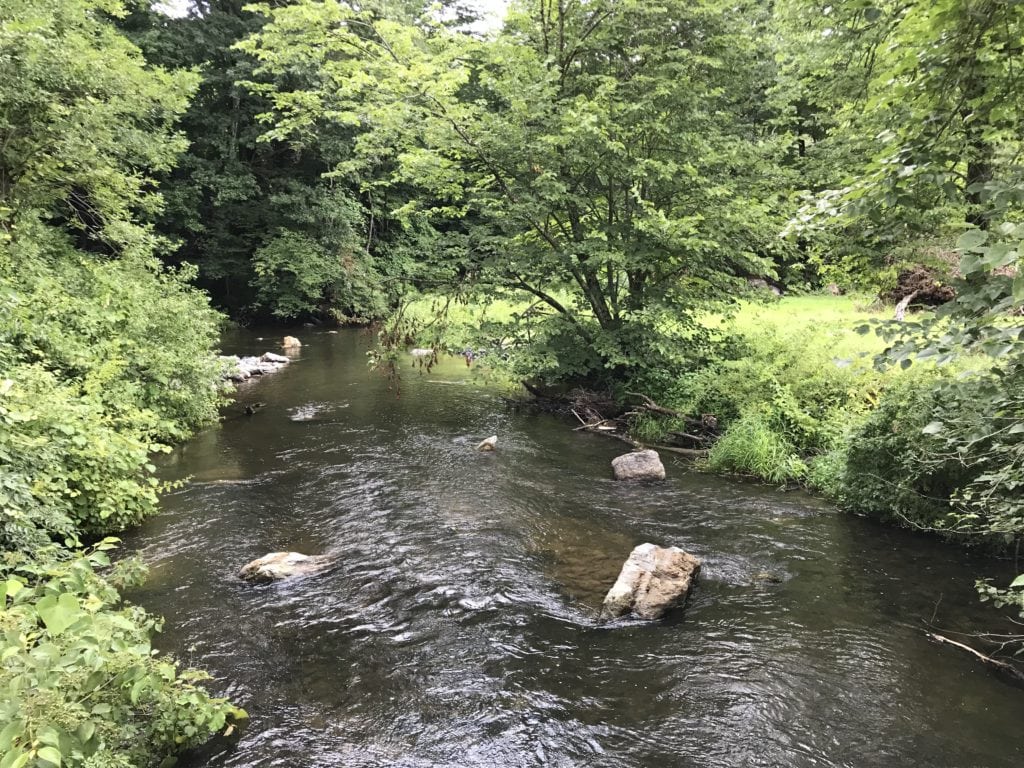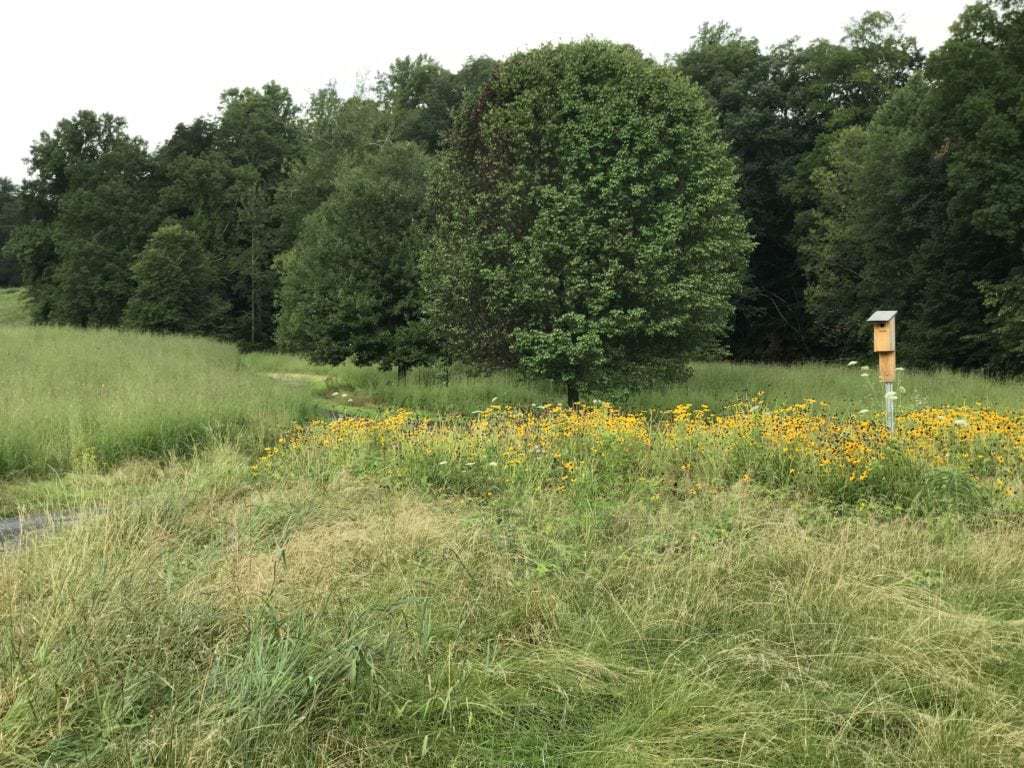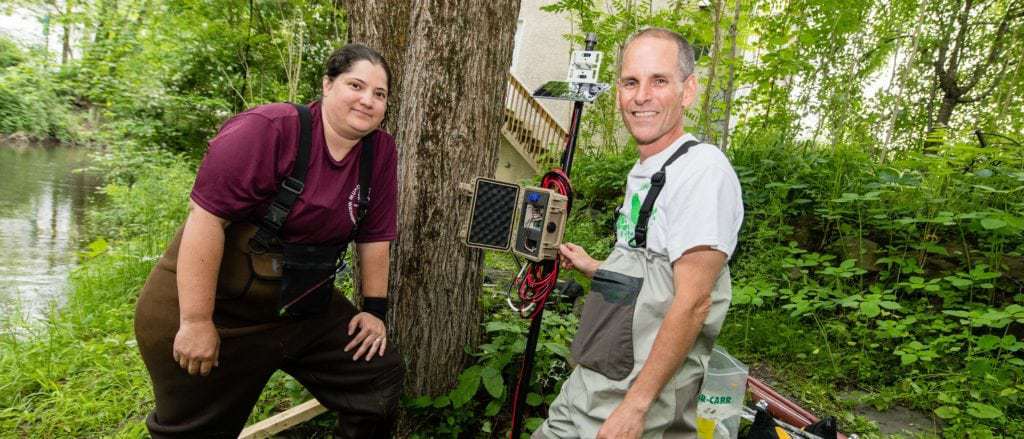Trout need clean water – so do we

To most of us, they are just spidery lines on a map, and the most contact we have with them is driving over some small barely noticed bridge.
But small streams named and unnamed are home to our water supply and to trout. Trout need clean water, and so do we. So Trout Unlimited recently took me on a tour of local streams to see what they -- and a host of others -- have been up to.
In shallow creeks and shaded streams, like the Cherry Creek just south of Stroudsburg, Pa., the water collects as it makes its way downhill to larger and larger waterways, which end up in the Delaware River.
A section of that creek is undergoing changes to make it more like nature intended and therefore more hospitable to trout.
Before Cherry Creek was naturalized -- see how flat and quiet the water is? PHOTO PROVIDED BY BRODHEAD CHAPTER OF TROUT UNLIMITED
After Cherry Creek was made more natural. Note how it has more structure in the water, preserved banks and shade. PHOTO PROVIDED BY BRODHEAD CHAPTER OF TROUT UNLIMITED
Craig Todd, Don Baylor, Rob Shane and Ed Cramer on a footbridge over Cherry Creek. PHOTO BY MEG MCGUIRE
Don Miller and Kathleen Flynn, both from the Broadhead chapter of Trout Unlimited explore for native wildflowers like butterfly weed and orange milkweed. PHOTO BY MEG MCGUIRE
Christa Reed, majoring in environmental studies at East Stroudsburg University works with Dr. Paul Wilson, an assistant professor of biological sciences to install monitors at Cherry Creek to record data about the stream like conductivity, turbidity and temperature. PHOTO PROVIDED BY EAST STROUDSBURG UNIVERSITY
It's part of the Cherry Valley National Wildlife Refuge and has been since 2008, under the wing of the U.S. Fish and Wildlife Service. Once upon a time, these 193 acres were a golf course, but only the barest outlines of its former use remain. What were once fairways are now thriving green swaths of tall grasses and trees. Native plants have also taken over the small hillocks which were the tees.
Encouraging native plants is no small job because most golf courses are created not with an eye to support the local flora and fauna, but to keep the course manicured and ready for golfers.
Edward Cramer, Stroud Township supervisor, knows a bit about how this tract of land was transformed. The unused golf course was prime for something. Development? Open space?
It took The Nature Conservancy along with some local interest and support (read money) from the township's Open Space Fund, as well as federal interest in some of the endangered species that live on the land, like the Bog Turtle, to create this refuge.
For every small creek in the Delaware River basin, there are legions of organizations and volunteers who are busy looking after our water and the lands that surround them.
In addition to the U.S. Fish and Wildlife Service, there's the Brodhead chapter of Trout Unlimited, the Brodhead Watershed Association, the Pocono Land Trust, Friends of Cherry Valley, PennFuture and the environmental sciences students (and professors) from East Stroudsburg University.
But the work doesn't stop with preservation.
This creek is getting some significant love to make it appealing for trout and to improve water quality. Before the recent work, the stream was running along sort of flat and simple. They call it channelized, which is the way we once thought wise: Make the water run downstream as quickly as possible to alleviate flooding.
Over time, we've discovered that rushing water downstream can create its own set of problems. Better to imitate how nature "organizes" its streams. Create a buffer on the edges from trees and plants that anchor the sides of the stream. Make sure there's some obstructions that force the water to both speed up and slow down. Monitor key water chemistry.
Tank Creek, one of the six Pocono streams that could become classified Exceptional Value -- the highest water quality assessment. PHOTO PROVIDED BY MEG MCGUIRE
A path at Fieldstone Farm Tank Creek Nature Preserve owned by Pocono Heritage Land Trust. PHOTO BY MEG MCGUIRE
On the northern end of Monroe County lie a handful of trout streams that are in their own quiet way the center of a clean-water controversy: Cranberry Creek, (upper) Paradise Creek, Tank Creek, Devil’s Hole Creek, Swiftwater Creek, and Tunkhannock Creek.
All Pennsylvania streams have classifications mainly based on how clean they are. There's almost an automatic designation of High Quality for streams in the Poconos, which is a state Department of Environmental Protection designation.
Sometimes, local environmental groups, like Trout Unlimited or another of the groups listed above, petition for a higher value to be placed on streams, which is what has happened for these streams.
These streams, after inspection by the state, have become or are becoming Exceptional Value streams -- the highest rating for water quality.
Except another local group made up of local businesses and landowners and called, confusingly, Monroe County Clean Stream Coalition, want to block that new designation.
This can get a little squirrelly, but as best I can translate what a very patient Abigail Jones, staff attorney for PennFuture, explained -- the designation of High Quality allows for waste water from surrounding development to get piped into a high-quality stream but it has to meet certain stringent standards, with one loophole. If there is a socio-economic reason for the standards not to apply, they can be given a pass.
If they are Exceptional Value, there's no pass.
There are many waste water treatment plants along Pocono streams and rivers, which are key to developing undeveloped land. According to Jones, the Exceptional Value designation keeps the streams cleaner.
"The designation doesn't mean there can't be development, rather that the development has to be thoughtful, with more care taken to insure the waste is treated with the care needed for such a stream."
Jones said that the state DEP has permitted about 100 such sensitive discharge plants in the state, which includes sewage systems, stormwater discharges and discharges from mining operations in the state.
One stream among these six is Tank Stream, protected on one side by State Game Lands and the other by Fieldstone Farm Tank Creek Nature Preserve, owned by the Pocono Heritage Land Trust. The farm has old buildings, freshwater ponds, springs, a mix of habitats and paths that wander throughout.
Tank Creek itself is deep in a small valley, with banks of trees, bushes and rocks. Doesn't seem like a great place for fly fishing since there's not much room to cast, but it does look like a perfect spot for trout.
Don Miller, who volunteers for Pocono Heritage Land Trust, Brodhead Watershed Association and the Brodhead chapter of Trout Unlimited, is more than a little fond of supporting not just any trout, but the wild brook trout, native to the Poconos. For him, it's important that we keep local species in habitats that allow them to thrive.
These days we tend to think that New York state has a storied pedigree that eclipses the Poconos when it comes to trout fishing. Not so, explained Robert Shane, from Trout Unlimited.
Before the devastating flood of 1955, the Poconos were the place to go for great trout fishing. And though there has been trout fishing in New York, it was the construction of the two dams on the West and East Branches of the Delaware that really gave rise to notable trout fishing there.
I'll leave that to the enthusiasts in both states to argue over.
There's no argument from conservationists about the value of protecting the trout, the habitat they thrive in and the surrounding lands. This protection protects us as well.
Craig Todd, who is retired from the Monroe County Conservation District, explained that it's local action that will keep water clean and safe to drink. "Many people think there are federal guidelines in place that keep our water safe. In a way, that's true, but those guidelines have to be observed and regulated.
"Clean water is a local issue."
In addition to cold, clear water, trout like nooks and crannies to lurk in, quiet places to rest and places where the water moves fast so the insects come to them while they wait behind a rock.
Don Baylor, from Trout Unlimited described it as "when there's structure in the waterway, it gives trout a place to rest, and also a place to go shopping for food."
It seems people and trout have a lot in common.










